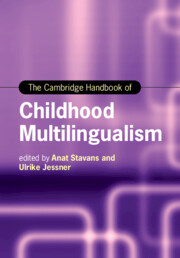Book contents
- The Cambridge Handbook of Childhood Multilingualism
- Cambridge Handbooks in Language and Linguistics
- The Cambridge Handbook of Childhood Multilingualism
- Copyright page
- Contents
- Figures
- Tables
- About the Editors
- Contributors
- Acknowledgments
- Multilingualism Is Not Bilingualism +1: An Introduction
- Part One Becoming and Being a Multilingual Child
- 1 Infant Bi- and Multilingual Development
- 2 The Development of Childhood Multilingualism in Languages of Different Modalities
- 3 Multilingualism in Early Childhood: The Role of the Input
- 4 Multilingual Education in Formal Schooling: Conceptual Shifts in Theory, Policy and Practice
- Part Two Cognition and Faculties in Multilinguals
- Part Three Family Language Policy
- Part Four Language(s) and Literacy of Multilingual Children through Schooling
- Part Five Socialization in Childhood Multilingualism
- Part Six Multilingual Children’s Landscape
- Subject Index
- Country Index
- Language Index
- References
4 - Multilingual Education in Formal Schooling: Conceptual Shifts in Theory, Policy and Practice
from Part One - Becoming and Being a Multilingual Child
Published online by Cambridge University Press: 18 August 2022
- The Cambridge Handbook of Childhood Multilingualism
- Cambridge Handbooks in Language and Linguistics
- The Cambridge Handbook of Childhood Multilingualism
- Copyright page
- Contents
- Figures
- Tables
- About the Editors
- Contributors
- Acknowledgments
- Multilingualism Is Not Bilingualism +1: An Introduction
- Part One Becoming and Being a Multilingual Child
- 1 Infant Bi- and Multilingual Development
- 2 The Development of Childhood Multilingualism in Languages of Different Modalities
- 3 Multilingualism in Early Childhood: The Role of the Input
- 4 Multilingual Education in Formal Schooling: Conceptual Shifts in Theory, Policy and Practice
- Part Two Cognition and Faculties in Multilinguals
- Part Three Family Language Policy
- Part Four Language(s) and Literacy of Multilingual Children through Schooling
- Part Five Socialization in Childhood Multilingualism
- Part Six Multilingual Children’s Landscape
- Subject Index
- Country Index
- Language Index
- References
Summary
This chapter examines models of multilingual education currently implemented in formal education systems around the world. Within the presentation of these models the chapter addresses the ideologies underlying the conceptualisations of the various programmes, the issue of the choice of language to be learned in relation to local contexts, types of learners enrolled in these programmes and the diverse outcomes of these models. This overview will (1) provide a backdrop to a discussion on the dominance of English and dominant European languages within these curricula, and (2) address the minoritisation of migrant and indigenous minority speakers’ bi-multilingualism and home languages. We conclude with a discussion of new approaches to the conceptualisation of multilingual education as a more flexible and dynamic process and the impact of such findings for language policymakers and educators at all levels.
Keywords
- Type
- Chapter
- Information
- The Cambridge Handbook of Childhood Multilingualism , pp. 82 - 110Publisher: Cambridge University PressPrint publication year: 2022
References
- 3
- Cited by

